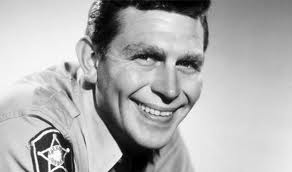Losing Andy Griffith
 I’ve written a lot about the clumsy, painful ways that America’s national culture thinks about rural life. It often amounts to a sort of minstrel show, with small-town characters translated into buffoonish caricatures.
I’ve written a lot about the clumsy, painful ways that America’s national culture thinks about rural life. It often amounts to a sort of minstrel show, with small-town characters translated into buffoonish caricatures.
The list of these shameful parodies is long, reaching an all-time low with Paris Hilton’s The Simple Life, which aired from 2003 through 2007.
From the Beverly Hillbillies to Hee-Haw to Green Acres, an entire genre of television has grown up around the notion that people living outside of urban America are rubes, hicks, and goofballs.
Into that troubled media landscape came the Andy Griffith show, which aired from 1960 to 1968, and then lived on in syndication. I grew up watching the black-and-white program after school in the late ’70s and early ’80s.
Griffith, who passed away this week, played the golden hearted, but often inadequate or uncertain father and sheriff. He was a single parent in an age when single parents weren’t common in television.
The show wasn’t immune to the tropes of the genre. Things could get pretty silly, with plenty of small town slapstick and corn-pone hijinks.
But this was the 19060s and the Andy Griffith Show tackled some pretty compelling issues, ranging from the growing independence of women in small town life, to rural poverty, to the growing influence of urban culture.
At one point, Opie even joins a rock and roll band!
While sitting around Floyd’s barber shop, the men of Mayberry chewed over everything from the Cold War to the space race.
Don’t get me wrong. This wasn’t To Kill A Mockingbird. The show, which was set in the South during the Civil Rights era, paid little attention to the crisis of race in America.
But the portrayal of rural life was, with rare exceptions, sympathetic and loving. Yes, Mayberry was a romanticized place. But it had recognizable textures, capturing real nuances of the actual experience of small towns.
There is small-minded Babbitry, but there is also neighborliness, tradition, and a human pace.
And certainly when compared with the less savory portraits of non-urban culture, it transcended the genre.
The Andy Griffith show was, also, often simply a joy to watch. I wish that more Americans these days had an entry point, a window into our way of life, as humorous, as warm and as cleverly written.
Tags: media, nc identity








It was a good show but I wonder how many heard or read this news and wondered who was Andy Griffith.
Pete – Yes, I think you’re right. Though a lot of this old TV culture gets recycled fairly frequently in the 24/7 churn of cable and satellite.
Brian, NCPR
When I read about Andy Griffith’s passing I went to the IMDb web site and pulled up “Waitress”, the last thing I saw Andy Griffith in…and it had what I was hoping to see, a clip of him in a relatively small but significant part in that film. His character “Old Joe” is pretty removed from “Andy Taylor” in “Waitress” but what a wonderful performance. Pete – you may be right but this was a recent film (2007) and so a relatively recent performance…although the film is pretty quirky so may have not have gotten the attention of current pop culture, something “The Andy Griffith Show” of the 1960s was very much a part of. If you want another very different look at Andy Griffith’s range as an actor check out the 1957 film “A Face in the Crowd”…wow.
Brian,
I agree with you but would note one problem for some.
There are some who won’t watch any black and white movies or TV.
To me this is odd because I often prefer the B&W.
I like watching Gunsmoke but prefer the B&W and especially prefer the half hour shows to the one hour shows.
One of the things I like best about B&W is how you can see what is taking place in the night scenes. In so many movies today the night scenes are so darkly “realistic” that you can’t see what is going on.